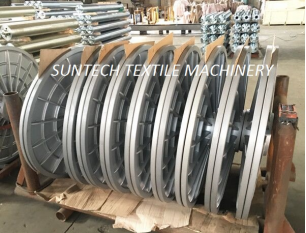With the development of differentiated fibers, the expansion of the market demand for functional fabrics and the popularization and application of a large number of high-speed shuttleless looms, looms have higher and stricter quality requirements for the required weaving shafts. The following is an introduction to the management of improving the quality of the weaving shaft and reducing the sizing defects.

1. Classification of shaft defects
Weaving shaft defects caused by sizing are roughly divided into four categories: artificial defects, mechanical defects, defects caused by the previous process and slurry defects. They are not independent of each other, and have a certain relationship and influence with each other. If a certain defect is not handled properly, it is likely to produce new and more serious defects. Therefore, when describing the names of defects and their causes, it is impossible to classify them into specific categories. In this paper, the quality problems of the weaving shaft itself and the physical quality defects of the cloth surface are attributed to the defects of the weaving shaft. Because there are many types of defects, only a few common defect prevention and treatment methods are listed.

2. Cause Analysis of Defects
Targeted early prevention and active take effective measures to eliminate sizing defects in time is the key to improving the intrinsic quality of the loom, and it is also the guarantee of improving the efficiency of the loom and product quality.
1) . Sizing rate
The sizing rate is a very important indicator for evaluating the quality of the sizing woven shaft. Too large or too small sizing rate will lead to an increase in warp breakage, which in turn affects the efficiency of the loom and product quality. The sizing rate is too small, the wear resistance of the warp yarn is weakened, the yarn surface is fuzzed, pilled, and warp breakage increases during the weaving process, and it is even impossible to weave.
2) . Elongation
In order to make the yarns evenly arranged and wound to meet the production needs, the warp yarns are allowed to bear a certain tension draft during the sizing process, but the tension draft should be controlled within an appropriate range. If the tension is too small, the production cannot be carried out smoothly; if the tension and elongation are too large, the yarn will lose its original elasticity and tenacity, which will increase the weaving end breakage. Generally, the elongation of pure cotton medium and thick yarn is not more than 1.5%, the fine yarn is not more than 1.2%, the chemical fiber yarn is not more than 0.8%, and the elongation qualification rate is not less than 90%
3) . Glue and line
The defect is mainly caused by human, mechanical and sizing factors, which means that the yarns are not separated from each other in the splitting area after sizing, and there are two or more warp yarns still sticking together.
4) . Plaque
Slurry appears in the slurry tank, the temperature difference between the four corners is large, the overflow plate is uneven, the slurry temperature is unstable, the quality of the warping shaft is often shut down, the operation speed of the lifting and lowering shaft is slow, the parking time is long, and the steam pressure control is unstable, etc. Plaster defects will occur. Sizing defects will not only cause warp sticking and end breakage, but also affect the efficiency of the loom. Serious sizing defects will also wear out the reed, causing defects such as warp shrinkage and holes in the fabric surface. Sometimes serious spots are difficult to remove, and the fabric can only be This cutting will cause long and undersized defects.
Improving the quality of the woven shaft and reducing the defects of the woven shaft are the basic guarantees to improve the efficiency of the loom and the quality of the product.
SUNTECH is a professional textile machinery manufacturer. We not only have warp beams, but also warp beam carrier. What’s more, we have a lot of fabric make-up machines, like fabric slitting machine for sale.




